Food and Beverage Operations Management
VerifiedAdded on 2023/01/12
|7
|1591
|94
AI Summary
This report discusses different types of food production systems, food and beverage service methods, and food production control and volume forecasting in the hospitality industry. It provides insights and recommendations for managing a restaurant effectively.
Contribute Materials
Your contribution can guide someone’s learning journey. Share your
documents today.

Food and Beverage
Operations
Management
Operations
Management
Secure Best Marks with AI Grader
Need help grading? Try our AI Grader for instant feedback on your assignments.
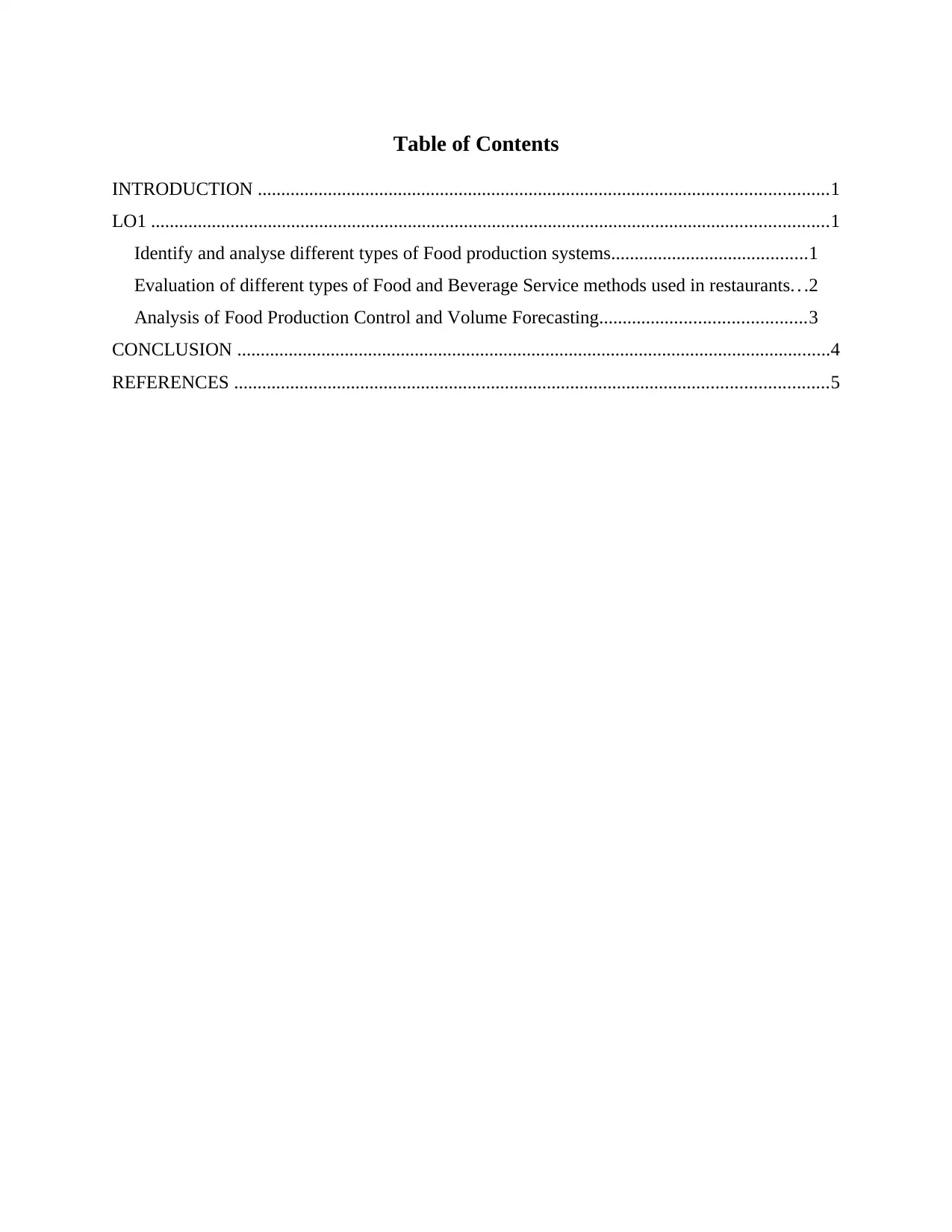
Table of Contents
INTRODUCTION ..........................................................................................................................1
LO1 .................................................................................................................................................1
Identify and analyse different types of Food production systems..........................................1
Evaluation of different types of Food and Beverage Service methods used in restaurants. . .2
Analysis of Food Production Control and Volume Forecasting............................................3
CONCLUSION ...............................................................................................................................4
REFERENCES ...............................................................................................................................5
INTRODUCTION ..........................................................................................................................1
LO1 .................................................................................................................................................1
Identify and analyse different types of Food production systems..........................................1
Evaluation of different types of Food and Beverage Service methods used in restaurants. . .2
Analysis of Food Production Control and Volume Forecasting............................................3
CONCLUSION ...............................................................................................................................4
REFERENCES ...............................................................................................................................5

INTRODUCTION
Hospitality industry is huge spread in wider range having many different segments such
as, hotels, motels, restaurants, cafes, food joints, bars etc. Food and Beverage is the most
important product which is rendered by hospitality service provider (Reid and Sanders, 2019).
This report is base_1584188956 (4)d on a case study of Lisa, who is responsible for managing
opening and functions of a restaurant named as Alfredo's. The assignment covers types of food
production systems which can be used by Lisa along with food and beverage service methods.
LO1
Identify and analyse different types of Food production systems
Food production systems are many types which defines the manner in which food is
being prepared, how it is severed and in what time span. Food production systems also,
determines how the food&beverages which are prepared should be stored and the required
equipments to do so. There are broadly four types of food production systems which are as
follows:1. Conventional service is the traditional form of food production service, in which menu
items or ordered food is prepared an stored for very short mostly till the serving time. It is
most commonly used system, where food items are purchased for a particular premises,
food is prepared and served at the same premise (Babich and Hilary, 2019).2. Ready prepared service was established for cutting down the labour cost and due to
shortage of food production experts. In this form of service food is produced and stored
by the restaurant owner, once they get orders accordingly food is reheated and served to
customers.3. Centralized service is the result of technological development and sophisticated food
service equipments. In commissary service food is produced in large centralized kitchens
and delivered to different service units located in separate areas. In commissary food
production system food is semi-prepared, once it reaches the service unit them the
provider cooks the food according to the demand and preferences of their guests. Such
services are mostly used by airlines caterers or chain restaurants.
4. Cook chill service of food production is where food is prepared and stored in huge
refrigerators. The food is prepared in bulk and stored in a refrigeration units where a
1
Hospitality industry is huge spread in wider range having many different segments such
as, hotels, motels, restaurants, cafes, food joints, bars etc. Food and Beverage is the most
important product which is rendered by hospitality service provider (Reid and Sanders, 2019).
This report is base_1584188956 (4)d on a case study of Lisa, who is responsible for managing
opening and functions of a restaurant named as Alfredo's. The assignment covers types of food
production systems which can be used by Lisa along with food and beverage service methods.
LO1
Identify and analyse different types of Food production systems
Food production systems are many types which defines the manner in which food is
being prepared, how it is severed and in what time span. Food production systems also,
determines how the food&beverages which are prepared should be stored and the required
equipments to do so. There are broadly four types of food production systems which are as
follows:1. Conventional service is the traditional form of food production service, in which menu
items or ordered food is prepared an stored for very short mostly till the serving time. It is
most commonly used system, where food items are purchased for a particular premises,
food is prepared and served at the same premise (Babich and Hilary, 2019).2. Ready prepared service was established for cutting down the labour cost and due to
shortage of food production experts. In this form of service food is produced and stored
by the restaurant owner, once they get orders accordingly food is reheated and served to
customers.3. Centralized service is the result of technological development and sophisticated food
service equipments. In commissary service food is produced in large centralized kitchens
and delivered to different service units located in separate areas. In commissary food
production system food is semi-prepared, once it reaches the service unit them the
provider cooks the food according to the demand and preferences of their guests. Such
services are mostly used by airlines caterers or chain restaurants.
4. Cook chill service of food production is where food is prepared and stored in huge
refrigerators. The food is prepared in bulk and stored in a refrigeration units where a
1
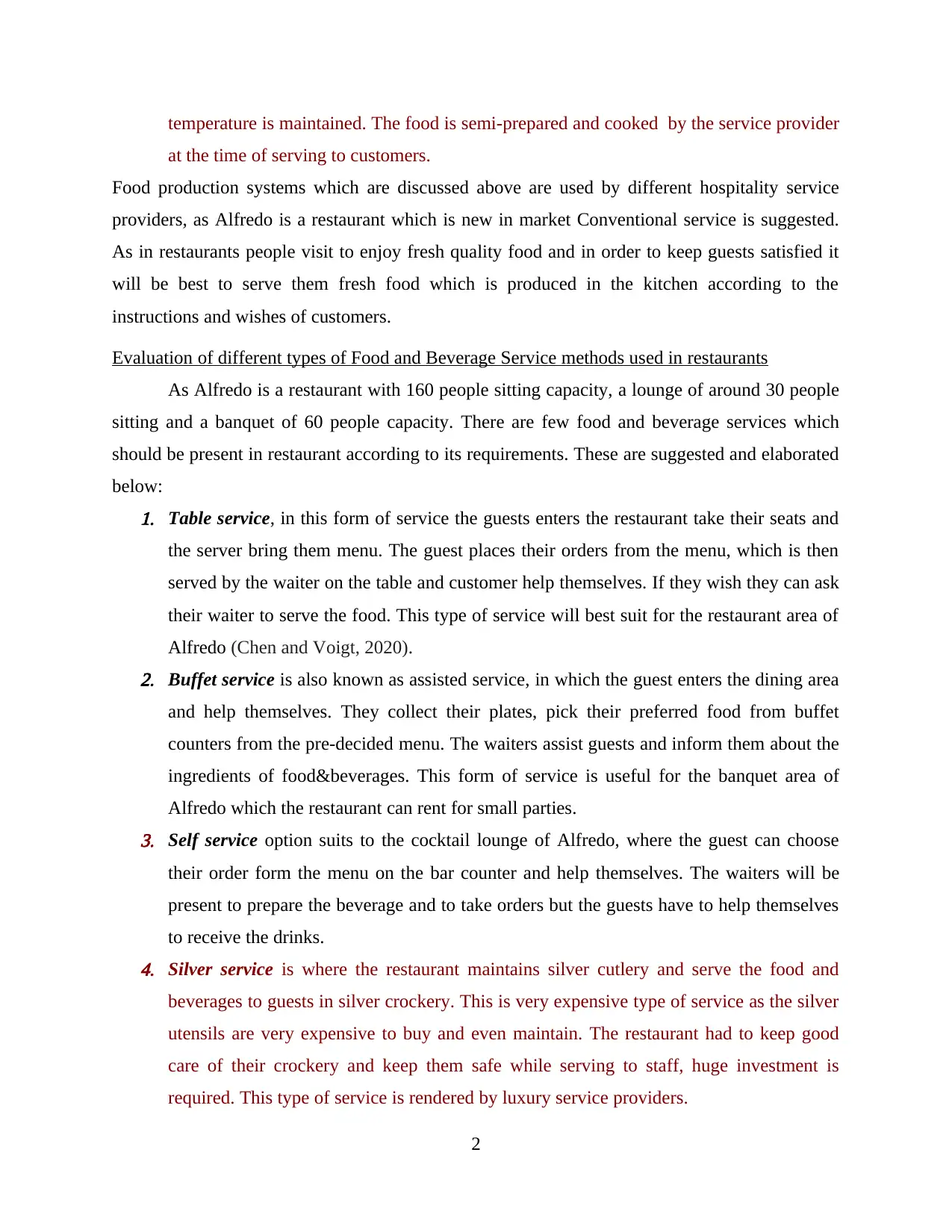
temperature is maintained. The food is semi-prepared and cooked by the service provider
at the time of serving to customers.
Food production systems which are discussed above are used by different hospitality service
providers, as Alfredo is a restaurant which is new in market Conventional service is suggested.
As in restaurants people visit to enjoy fresh quality food and in order to keep guests satisfied it
will be best to serve them fresh food which is produced in the kitchen according to the
instructions and wishes of customers.
Evaluation of different types of Food and Beverage Service methods used in restaurants
As Alfredo is a restaurant with 160 people sitting capacity, a lounge of around 30 people
sitting and a banquet of 60 people capacity. There are few food and beverage services which
should be present in restaurant according to its requirements. These are suggested and elaborated
below:1. Table service, in this form of service the guests enters the restaurant take their seats and
the server bring them menu. The guest places their orders from the menu, which is then
served by the waiter on the table and customer help themselves. If they wish they can ask
their waiter to serve the food. This type of service will best suit for the restaurant area of
Alfredo (Chen and Voigt, 2020).2. Buffet service is also known as assisted service, in which the guest enters the dining area
and help themselves. They collect their plates, pick their preferred food from buffet
counters from the pre-decided menu. The waiters assist guests and inform them about the
ingredients of food&beverages. This form of service is useful for the banquet area of
Alfredo which the restaurant can rent for small parties.3. Self service option suits to the cocktail lounge of Alfredo, where the guest can choose
their order form the menu on the bar counter and help themselves. The waiters will be
present to prepare the beverage and to take orders but the guests have to help themselves
to receive the drinks.4. Silver service is where the restaurant maintains silver cutlery and serve the food and
beverages to guests in silver crockery. This is very expensive type of service as the silver
utensils are very expensive to buy and even maintain. The restaurant had to keep good
care of their crockery and keep them safe while serving to staff, huge investment is
required. This type of service is rendered by luxury service providers.
2
at the time of serving to customers.
Food production systems which are discussed above are used by different hospitality service
providers, as Alfredo is a restaurant which is new in market Conventional service is suggested.
As in restaurants people visit to enjoy fresh quality food and in order to keep guests satisfied it
will be best to serve them fresh food which is produced in the kitchen according to the
instructions and wishes of customers.
Evaluation of different types of Food and Beverage Service methods used in restaurants
As Alfredo is a restaurant with 160 people sitting capacity, a lounge of around 30 people
sitting and a banquet of 60 people capacity. There are few food and beverage services which
should be present in restaurant according to its requirements. These are suggested and elaborated
below:1. Table service, in this form of service the guests enters the restaurant take their seats and
the server bring them menu. The guest places their orders from the menu, which is then
served by the waiter on the table and customer help themselves. If they wish they can ask
their waiter to serve the food. This type of service will best suit for the restaurant area of
Alfredo (Chen and Voigt, 2020).2. Buffet service is also known as assisted service, in which the guest enters the dining area
and help themselves. They collect their plates, pick their preferred food from buffet
counters from the pre-decided menu. The waiters assist guests and inform them about the
ingredients of food&beverages. This form of service is useful for the banquet area of
Alfredo which the restaurant can rent for small parties.3. Self service option suits to the cocktail lounge of Alfredo, where the guest can choose
their order form the menu on the bar counter and help themselves. The waiters will be
present to prepare the beverage and to take orders but the guests have to help themselves
to receive the drinks.4. Silver service is where the restaurant maintains silver cutlery and serve the food and
beverages to guests in silver crockery. This is very expensive type of service as the silver
utensils are very expensive to buy and even maintain. The restaurant had to keep good
care of their crockery and keep them safe while serving to staff, huge investment is
required. This type of service is rendered by luxury service providers.
2
Secure Best Marks with AI Grader
Need help grading? Try our AI Grader for instant feedback on your assignments.
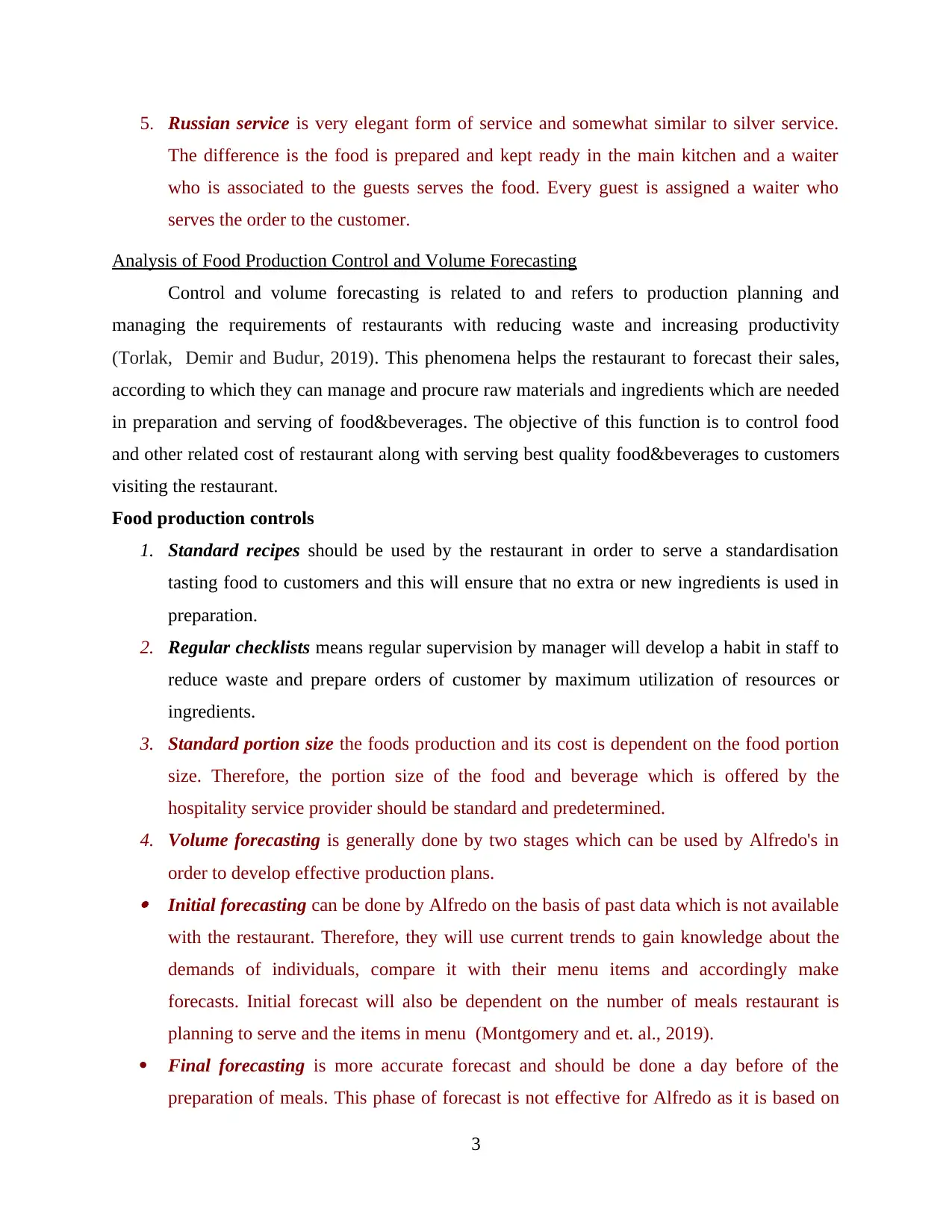
5. Russian service is very elegant form of service and somewhat similar to silver service.
The difference is the food is prepared and kept ready in the main kitchen and a waiter
who is associated to the guests serves the food. Every guest is assigned a waiter who
serves the order to the customer.
Analysis of Food Production Control and Volume Forecasting
Control and volume forecasting is related to and refers to production planning and
managing the requirements of restaurants with reducing waste and increasing productivity
(Torlak, Demir and Budur, 2019). This phenomena helps the restaurant to forecast their sales,
according to which they can manage and procure raw materials and ingredients which are needed
in preparation and serving of food&beverages. The objective of this function is to control food
and other related cost of restaurant along with serving best quality food&beverages to customers
visiting the restaurant.
Food production controls
1. Standard recipes should be used by the restaurant in order to serve a standardisation
tasting food to customers and this will ensure that no extra or new ingredients is used in
preparation.
2. Regular checklists means regular supervision by manager will develop a habit in staff to
reduce waste and prepare orders of customer by maximum utilization of resources or
ingredients.
3. Standard portion size the foods production and its cost is dependent on the food portion
size. Therefore, the portion size of the food and beverage which is offered by the
hospitality service provider should be standard and predetermined.
4. Volume forecasting is generally done by two stages which can be used by Alfredo's in
order to develop effective production plans. Initial forecasting can be done by Alfredo on the basis of past data which is not available
with the restaurant. Therefore, they will use current trends to gain knowledge about the
demands of individuals, compare it with their menu items and accordingly make
forecasts. Initial forecast will also be dependent on the number of meals restaurant is
planning to serve and the items in menu (Montgomery and et. al., 2019).
Final forecasting is more accurate forecast and should be done a day before of the
preparation of meals. This phase of forecast is not effective for Alfredo as it is based on
3
The difference is the food is prepared and kept ready in the main kitchen and a waiter
who is associated to the guests serves the food. Every guest is assigned a waiter who
serves the order to the customer.
Analysis of Food Production Control and Volume Forecasting
Control and volume forecasting is related to and refers to production planning and
managing the requirements of restaurants with reducing waste and increasing productivity
(Torlak, Demir and Budur, 2019). This phenomena helps the restaurant to forecast their sales,
according to which they can manage and procure raw materials and ingredients which are needed
in preparation and serving of food&beverages. The objective of this function is to control food
and other related cost of restaurant along with serving best quality food&beverages to customers
visiting the restaurant.
Food production controls
1. Standard recipes should be used by the restaurant in order to serve a standardisation
tasting food to customers and this will ensure that no extra or new ingredients is used in
preparation.
2. Regular checklists means regular supervision by manager will develop a habit in staff to
reduce waste and prepare orders of customer by maximum utilization of resources or
ingredients.
3. Standard portion size the foods production and its cost is dependent on the food portion
size. Therefore, the portion size of the food and beverage which is offered by the
hospitality service provider should be standard and predetermined.
4. Volume forecasting is generally done by two stages which can be used by Alfredo's in
order to develop effective production plans. Initial forecasting can be done by Alfredo on the basis of past data which is not available
with the restaurant. Therefore, they will use current trends to gain knowledge about the
demands of individuals, compare it with their menu items and accordingly make
forecasts. Initial forecast will also be dependent on the number of meals restaurant is
planning to serve and the items in menu (Montgomery and et. al., 2019).
Final forecasting is more accurate forecast and should be done a day before of the
preparation of meals. This phase of forecast is not effective for Alfredo as it is based on
3
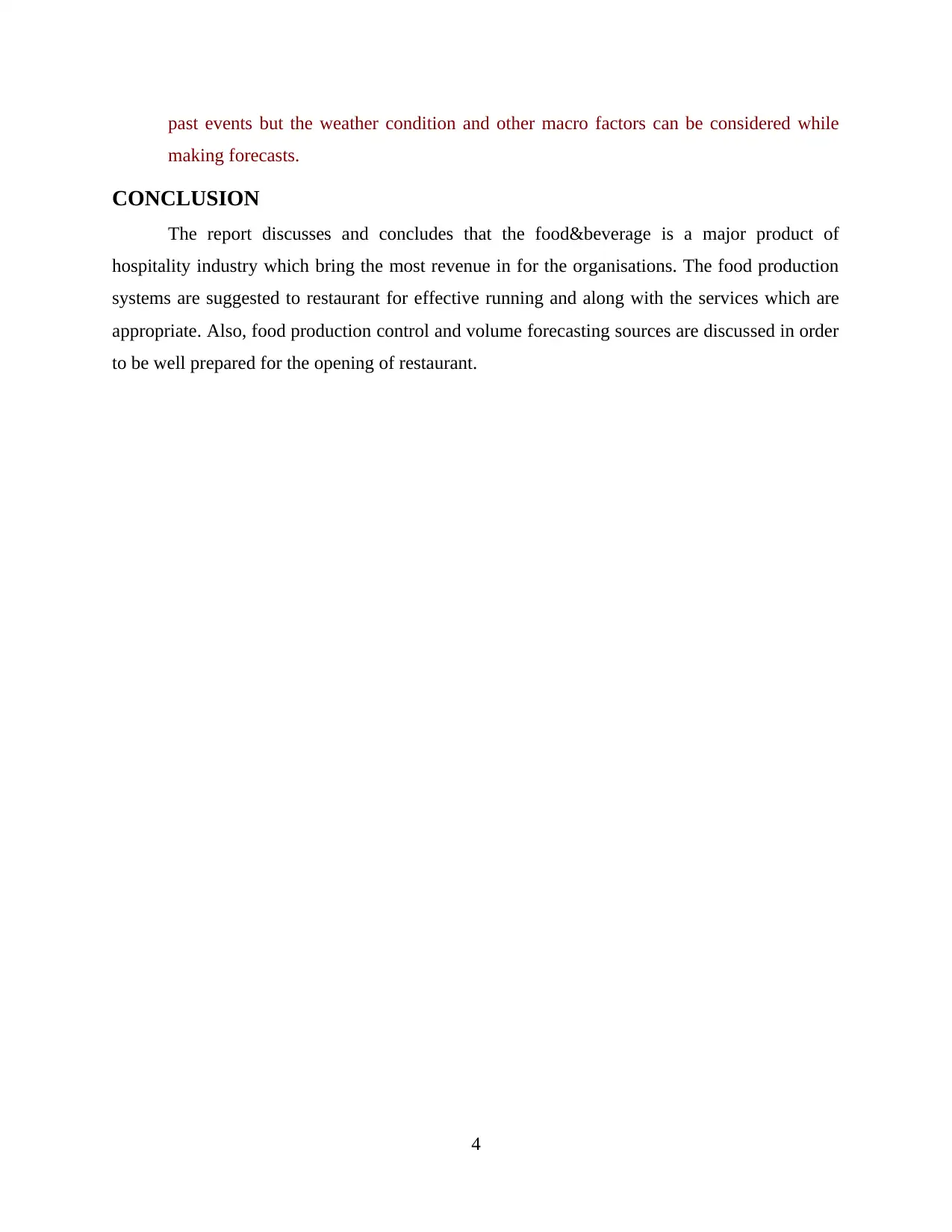
past events but the weather condition and other macro factors can be considered while
making forecasts.
CONCLUSION
The report discusses and concludes that the food&beverage is a major product of
hospitality industry which bring the most revenue in for the organisations. The food production
systems are suggested to restaurant for effective running and along with the services which are
appropriate. Also, food production control and volume forecasting sources are discussed in order
to be well prepared for the opening of restaurant.
4
making forecasts.
CONCLUSION
The report discusses and concludes that the food&beverage is a major product of
hospitality industry which bring the most revenue in for the organisations. The food production
systems are suggested to restaurant for effective running and along with the services which are
appropriate. Also, food production control and volume forecasting sources are discussed in order
to be well prepared for the opening of restaurant.
4
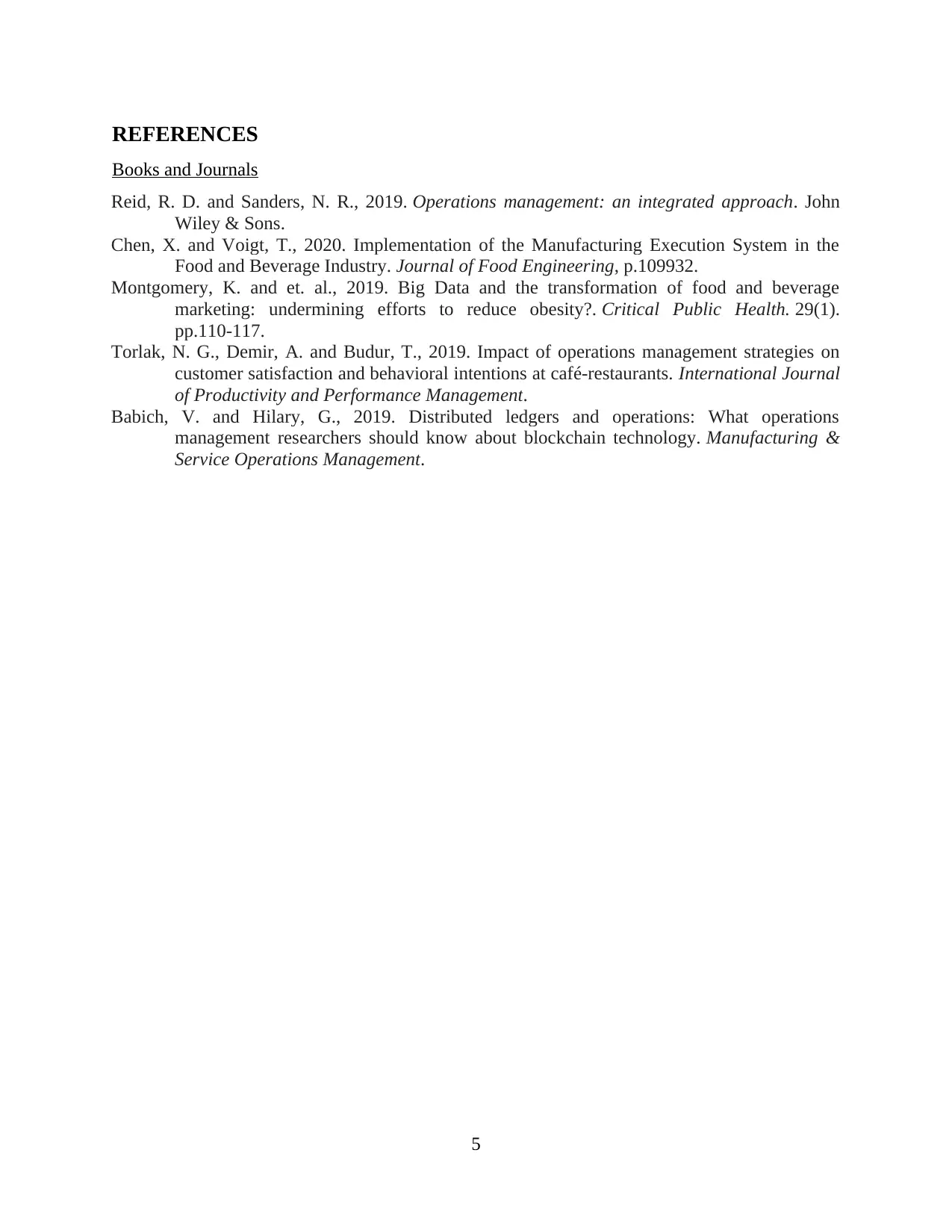
REFERENCES
Books and Journals
Reid, R. D. and Sanders, N. R., 2019. Operations management: an integrated approach. John
Wiley & Sons.
Chen, X. and Voigt, T., 2020. Implementation of the Manufacturing Execution System in the
Food and Beverage Industry. Journal of Food Engineering, p.109932.
Montgomery, K. and et. al., 2019. Big Data and the transformation of food and beverage
marketing: undermining efforts to reduce obesity?. Critical Public Health. 29(1).
pp.110-117.
Torlak, N. G., Demir, A. and Budur, T., 2019. Impact of operations management strategies on
customer satisfaction and behavioral intentions at café-restaurants. International Journal
of Productivity and Performance Management.
Babich, V. and Hilary, G., 2019. Distributed ledgers and operations: What operations
management researchers should know about blockchain technology. Manufacturing &
Service Operations Management.
5
Books and Journals
Reid, R. D. and Sanders, N. R., 2019. Operations management: an integrated approach. John
Wiley & Sons.
Chen, X. and Voigt, T., 2020. Implementation of the Manufacturing Execution System in the
Food and Beverage Industry. Journal of Food Engineering, p.109932.
Montgomery, K. and et. al., 2019. Big Data and the transformation of food and beverage
marketing: undermining efforts to reduce obesity?. Critical Public Health. 29(1).
pp.110-117.
Torlak, N. G., Demir, A. and Budur, T., 2019. Impact of operations management strategies on
customer satisfaction and behavioral intentions at café-restaurants. International Journal
of Productivity and Performance Management.
Babich, V. and Hilary, G., 2019. Distributed ledgers and operations: What operations
management researchers should know about blockchain technology. Manufacturing &
Service Operations Management.
5
1 out of 7
Related Documents
Your All-in-One AI-Powered Toolkit for Academic Success.
+13062052269
info@desklib.com
Available 24*7 on WhatsApp / Email
![[object Object]](/_next/static/media/star-bottom.7253800d.svg)
Unlock your academic potential
© 2024 | Zucol Services PVT LTD | All rights reserved.





